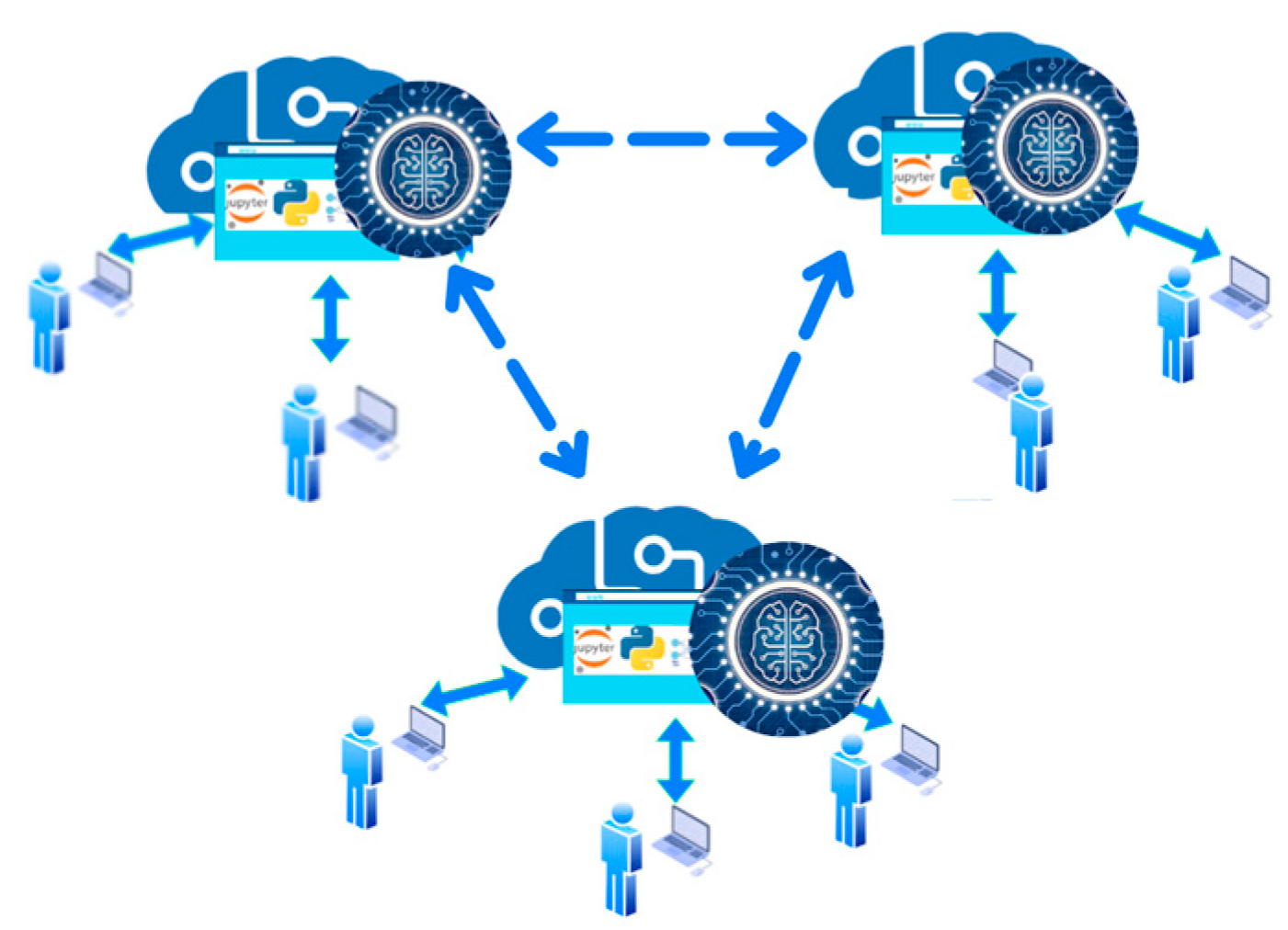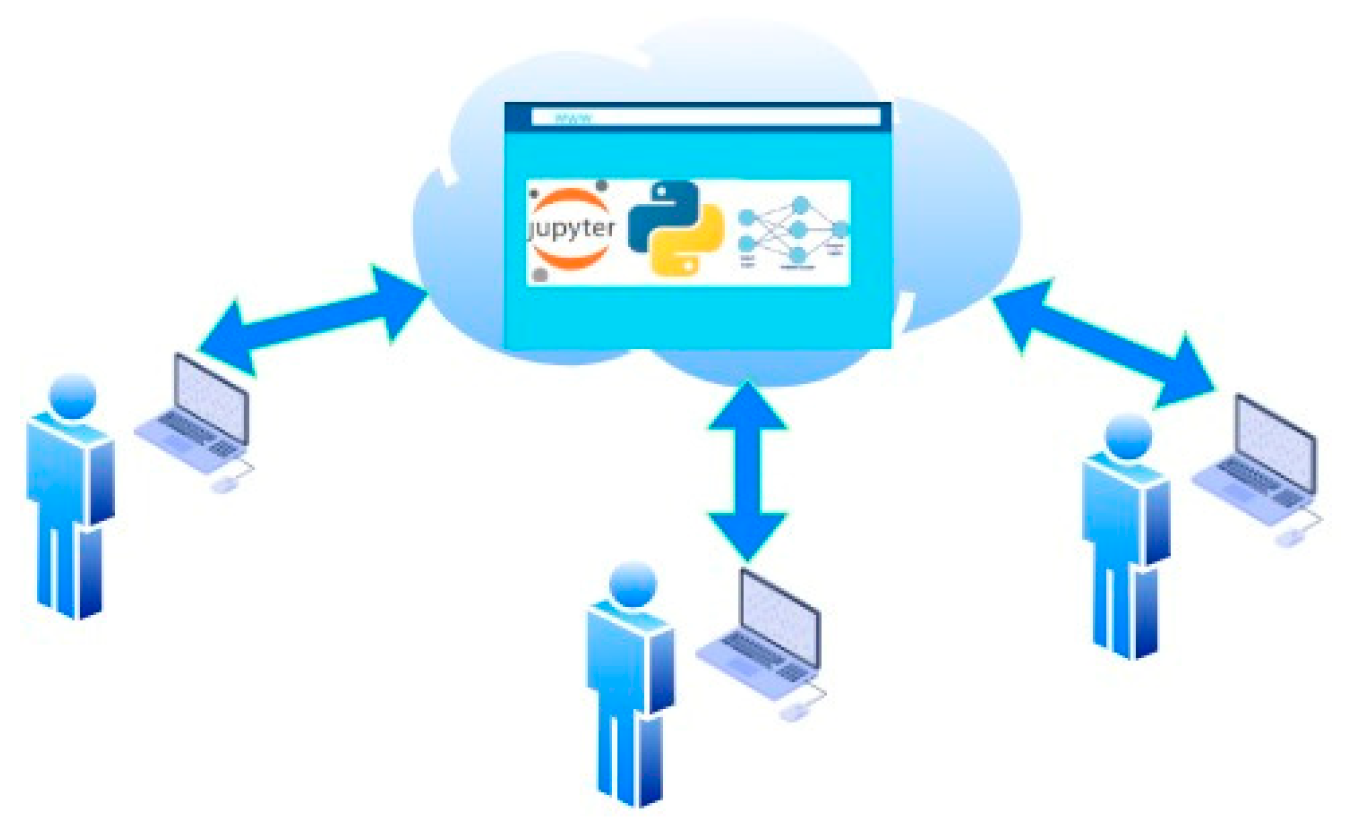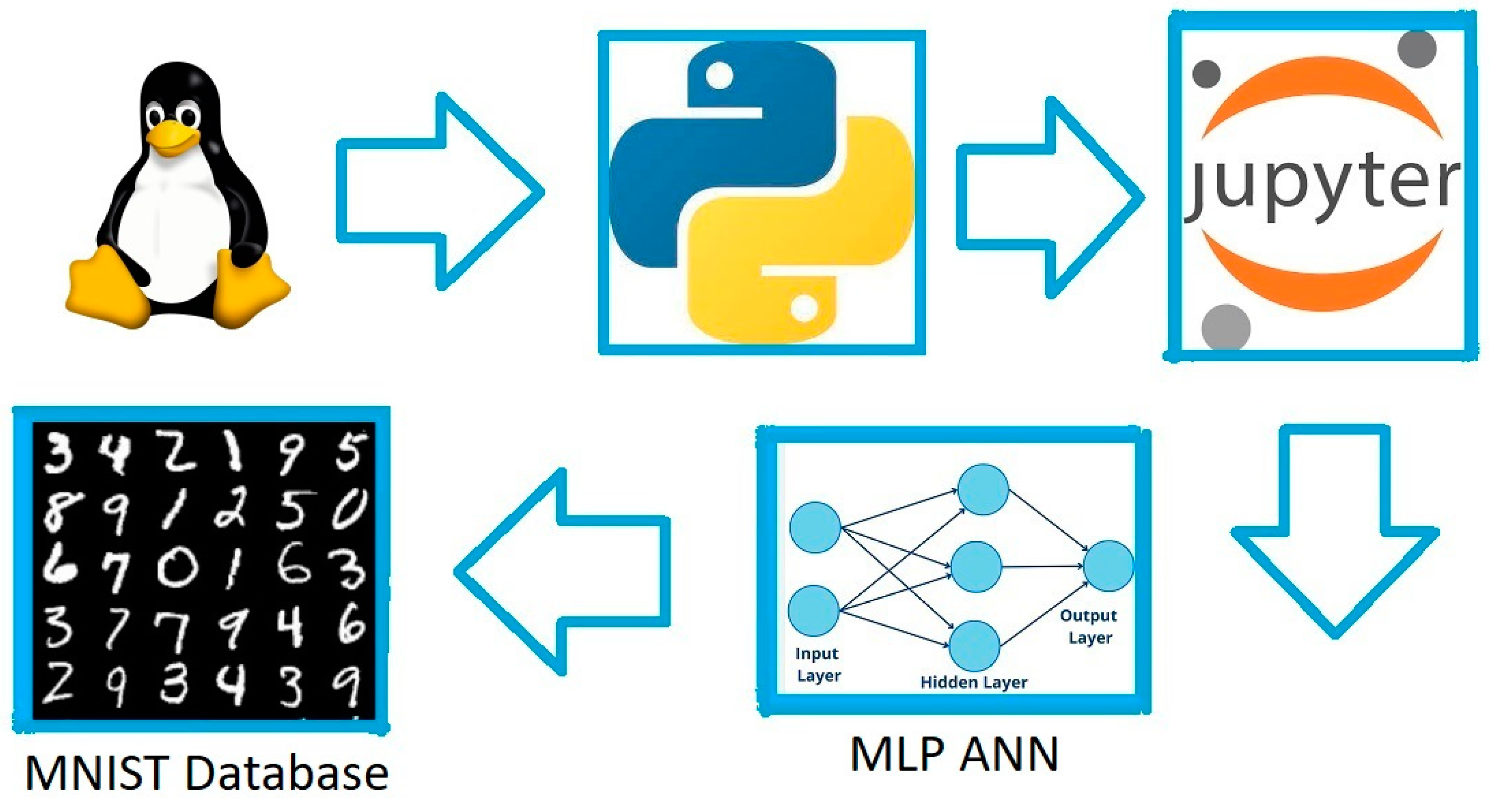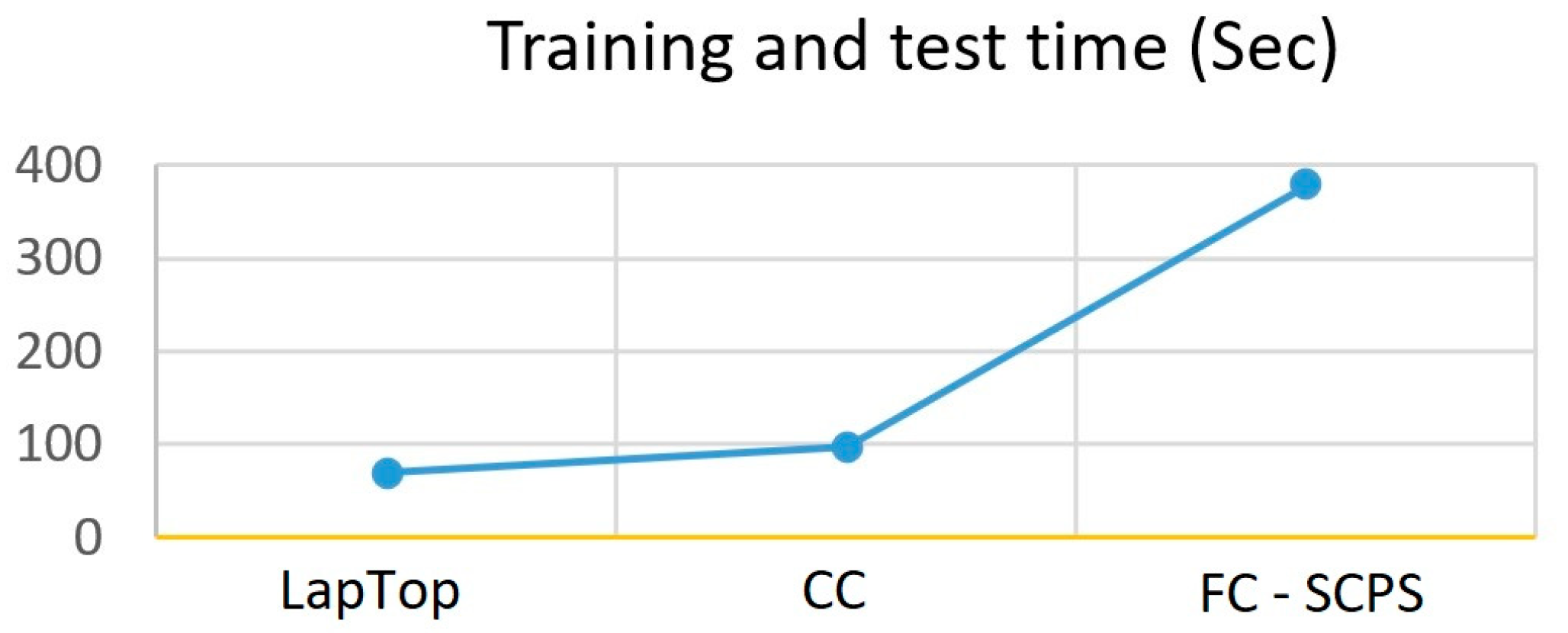Performance Analysis of Embedded Multilayer Perceptron Artificial Neural Networks on Smart Cyber-Physical Systems for IoT Environments
Abstract
1. Introduction
1.1. Industry 4.0 (I4.0)
1.2. Cyber-Physical Systems
1.3. Smart Cyber-Physical Systems
2. Materials and Methods
- Implementation technologies
- Implementation methodology
- Stage one. Implementation technologies
- Lower size, weight, cost, and power consumption;
- Lower data consumption;
- Reduce internet bottlenecks, which translates into less network congestion;
- Consequently, lower costs and lower latency;
- Less bandwidth consumption;
- Increases the security of encrypted data since the information is closer to the end-user, reducing exposure and vulnerability;
- Improved scalability potential is key in a sector with so much growth potential.
- Decreases the reaction time of the system;
- The system works even when there is no internet connection, a key factor when choosing a connected system;
- The risk of blockages or massive failures is considerably reduced since the intelligence is not tied to a single point but is dispersed in several action nuclei;
- Balance and equilibrium increased;
- The possibility to connect sensors and actuators on Input-Output ports.
- Stage two. Operating system and software
- Stage three. Selecting the data set
- Stage four. Training and testing the MLPANN
- -
- Achieving an accuracy above 97% to ensure satisfactory recognition by the network and to be among favorable accuracy results compared to other studies on digit recognition;
- -
- Avoiding overfit and minimizing training time costs;
- -
- Achieving similar performance across the three technologies used in this research.
3. Results
- Data analysis, continuous learning, and adaptation to improve real-time decision-making accuracy and capacity;
- Real-time identification and classification of objects, patterns, and events that enable interaction with the environment and real-time adjustment to face unforeseen scenarios.
4. Discussion
5. Conclusions
Author Contributions
Funding
Institutional Review Board Statement
Informed Consent Statement
Data Availability Statement
Acknowledgments
Conflicts of Interest
References
- Jiang, J.-R. An improved cyber-physical systems architecture for Industry 4.0 smart factories. Adv. Mech. Eng. 2018, 10, 1687814018784192. [Google Scholar] [CrossRef]
- Duo, W.; Zhou, M.; Abusorrah, A. A Survey of Cyber Attacks on Cyber Physical Systems: Recent Advances and Challenges. IEEE/CAA J. Autom. Sin. 2022, 9, 784–800. [Google Scholar] [CrossRef]
- ERDİL, A. Industry 4.0 Perception regarding to New Developments and New Trends of Industries. Eur. J. Sci. Technol. 2021. [CrossRef]
- Shrivastava, A.; Krishna, K.M.; Rinawa, M.L.; Soni, M.; Ramkumar, G.; Jaiswal, S. Inclusion of IoT, ML, and Blockchain Technologies in Next Generation Industry 4.0 Environment. Mater. Today Proc. 2021, 80, 3471–3475. [Google Scholar] [CrossRef]
- RZhong, Y.; Xu, X.; Klotz, E.; Newman, S.T. Intelligent Manufacturing in the Context of Industry 4.0: A Review. Engineering 2017, 3, 616–630. [Google Scholar] [CrossRef]
- Pivoto, D.G.S.; de Almeida, L.F.F.; Da Rosa Righi, R.; Rodrigues, J.J.P.C.; Lugli, A.B.; Alberti, A.M. Cyber-physical systems architectures for industrial internet of things applications in Industry 4.0: A literature review. J. Manuf. Syst. 2021, 58, 176–192. [Google Scholar] [CrossRef]
- Dalenogare, L.S.; Benitez, G.B.; Ayala, N.F.; Frank, A.G. The expected contribution of Industry 4.0 technologies for industrial performance. Int. J. Prod. Econ. 2018, 204, 383–394. [Google Scholar] [CrossRef]
- Klingenberg, C.O.; Borges, M.A.V.; Antunes, J.A.D.V. Industry 4.0: What makes it a revolution? A historical framework to understand the phenomenon. Technol. Soc. 2022, 70, 102009. [Google Scholar] [CrossRef]
- Lee, J.; Davari, H.; Singh, J.; Pandhare, V. Industrial Artificial Intelligence for industry 4.0-based manufacturing systems. Manuf. Lett. 2018, 18, 20–23. [Google Scholar] [CrossRef]
- Shah, K.; Patel, N.; Thakkar, J.; Patel, C. Exploring applications of blockchain technology for Industry 4.0. Mater. Today Proc. 2022, 62, 7238–7242. [Google Scholar] [CrossRef]
- Kotsiopoulos, T.; Sarigiannidis, P.; Ioannidis, D.; Tzovaras, D. Machine Learning and Deep Learning in smart manufacturing: The Smart Grid paradigm. Comput. Sci. Rev. 2021, 40, 100341. [Google Scholar] [CrossRef]
- Raval, M.B.; Joshi, H. Categorical framework for implementation of industry 4.0 techniques in medium-scale bearing manufacturing industries. Mater. Today Proc. 2022, 65, 3531–3537. [Google Scholar] [CrossRef]
- Pereira, A.C.; Romero, F. A review of the meanings and the implications of the Industry 4.0 concept. Procedia Manuf. 2017, 13, 1206–1214. [Google Scholar] [CrossRef]
- Navickas, V.; Kuznetsova, S.; Gruzauskas, V. Cyber–Physical Systems Expression in Industry 4.0 Context. Financ. Credit. Act. Probl. Theory Pract. 2017, 2, 188–197. [Google Scholar] [CrossRef]
- Tepjit, S.; Horvath, I.; Rus, Z. The state of framework development for implementing reasoning mechanisms in smart cyber-physical systems: A literature review. J. Comput. Des. Eng. 2019, 6, 527–541. [Google Scholar] [CrossRef]
- Yaacoub, J.-P.A.; Salman, O.; Noura, H.N.; Kaaniche, N.; Chehab, A.; Malli, M. Cyber-physical systems security: Limitations, issues and future trends. Microprocess. Microsyst. 2020, 77, 103201. [Google Scholar] [CrossRef]
- Villalba-Díez, J.; Molina, M.; Ordieres-Mer, J.; Sun, S.; Schmidt, D.; Wellbrock, W. Geometric Deep Lean Learning: Deep Learning in Industry 4.0 Cyber–Physical Complex Networks. Sensors 2020, 20, 763. [Google Scholar] [CrossRef]
- Persson, M.; Håkansson, A. A Communication Protocol for Different Communication Technologies in Cyber-Physical Systems. Procedia Comput. Sci. 2015, 60, 1697–1706. [Google Scholar] [CrossRef]
- Xu, H.; Yu, W.; Griffith, D.; Golmie, N. A Survey on Industrial Internet of Things: A Cyber-Physical Systems Perspective. IEEE Access 2018, 6, 78238–78259. [Google Scholar] [CrossRef]
- Tyagi, A.K.; Sreenath, N. Cyber Physical Systems: Analyses, challenges and possible solutions. Internet Things Cyber-Phys. Syst. 2021, 1, 22–33. [Google Scholar] [CrossRef]
- Delicato, F.C.; Al-Anbuky, A.; Wang, K.I.-K. Editorial: Smart Cyber–Physical Systems: Toward Pervasive Intelligence Systems. Future Gener. Comput. Syst. 2020, 107, 1134–1139. [Google Scholar] [CrossRef]
- Skowronski, R. The open blockchain-aided multi-agent symbiotic cyberphysical systems. Future Gener. Comput. Syst. 2018, 94, 430–443. [Google Scholar] [CrossRef]
- Bures, T.; Weyns, D.; Schmer, B.; Tovar, E.; Boden, E.; Gabor, T.; Gupta, P.; Kang, E.; Knauss, A.; Patel, P.; et al. Software Engineering for Smart Cyber-Physical Systems: Challenges and Promising Solutions. ACM SIGSOFT Softw. Eng. Notes 2017, 42, 19–24. [Google Scholar] [CrossRef]
- Radanliev, P.; De Roure, D.; Van Kleek, M.; Santos, O.; Ani, U. Artificial intelligence in cyber physical systems. AI SOCIETY 2021, 36, 783–796. [Google Scholar] [CrossRef]
- Nacchia, M.; Fruggiero, F.; Lambiase, A.; Bruton, K. A Systematic Mapping of the Advancing Use of Machine Learning Techniques for Predictive Maintenance in the Manufacturing Sector. Appl. Sci. 2021, 11, 2546. [Google Scholar] [CrossRef]
- Fei, X.; Shah, N.; Verba, N.; Chao, K.-M.; Sanchez-Anguix, V.; Lewandowski, J.; James, A.; Usman, Z. CPS data streams analytics based on machine learning for Cloud and Fog Computing: A survey. Future Gener. Comput. Syst. 2019, 90, 435–450. [Google Scholar] [CrossRef]
- Tav, J.; Horvath, I. A Review of the Principles of Designing Smart Cyber-Physical Systems for Run-Time Adaptation: Learned Lessons and Open Issues. IEEE Trans. Syst. Man Cybern. Syst. 2019, 49, 145–158. [Google Scholar] [CrossRef]
- Kalluri, B.; Chronopoulos, C.; Kozine, I. The concept of smartness in cyber–physical systems and connection to urban environment. Annu. Rev. Control. 2021, 51, 1–22. [Google Scholar] [CrossRef]
- Tavcar, J.; Duhovnik, J.; Horvath, I. From Validation of Medical Devices towards Validation of Adaptive Cyber-Physical Systems. J. Integr. Des. Process Sci. 2019, 23, 37–59. [Google Scholar] [CrossRef]
- Varadarajan, V.; Kommers, P.; Piuri, V. Preface of Special Issue on Advanced techniques and emerging trends in Smart Cyber–Physical Systems. Future Gener. Comput. Syst. 2022, 135, 299–302. [Google Scholar] [CrossRef]
- Al-Jaroodi, J.; Mohamed, N. PsCPS: A Distributed Platform for Cloud and Fog Integrated Smart Cyber-Physical Systems. IEEE Access 2018, 6, 41432–41449. [Google Scholar] [CrossRef]
- Bousdekis, A.; Apostolou, D.; Mentzas, G. A human cyber physical system framework for operator 4.0–artificial intelligence symbiosis. Manuf. Lett. 2020, 25, 10–15. [Google Scholar] [CrossRef]
- Bi, T.; Liu, Q.; Ozcelebi, T.; Jarnikov, D.; Sekulovski, D. PCANN: Distributed ANN Architecture for Image Recognition in Resource-Constrained IoT Devices. In Proceedings of the 2019 15th International Conference on Intelligent Environments (IE), Rabat, Morocco, 24–27 June 2019; pp. 1–8. [Google Scholar] [CrossRef]
- Del Campo, F.A.; Neri, M.C.; Villegas, O.O.; Sánchez, V.G.; Domínguez, H.D.; Jiménez, V.G. Auto-adaptive multilayer perceptron for univariate time series classification. Expert Syst. Appl. 2021, 181, 115147. [Google Scholar] [CrossRef]
- Hoffmann, L.F.S.; Bizarria, F.C.P.; Bizarria, J.W.P. Detection of liner surface defects in solid rocket motors using multilayer perceptron neural networks. Polym. Test. 2020, 88, 106559. [Google Scholar] [CrossRef]
- O’Donovan, P.; Gallagher, C.; Bruton, K.; O’Sullivan, D.T.J. A fog computing industrial cyber-physical system for embedded low-latency machine learning Industry 4.0 applications. Manuf. Lett. 2018, 15, 139–142. [Google Scholar] [CrossRef]
- Kaur, M.; Aron, R. Energy-aware load balancing in fog cloud computing. Mater. Today Proc. Dic. 2020. [Google Scholar] [CrossRef]
- What Is Cloud Computing|IGI Global. Available online: https://www.igi-global.com/dictionary/homehealthcare-cloud-computing/4037? (accessed on 14 February 2023).
- New Technologies for Business|Kaplan UK. Available online: https://kaplan.co.uk/courses/data-technology/new-technologies-for-business (accessed on 14 February 2023).
- Sobragi, C.G.; Mac, A.C.G.; Oliveira, M. Cloud Computing Adoption: A Multiple Case Study. BASE Rev. Adm. E Contab. Da Unisinos 2014, 11, 75–91. [Google Scholar]
- Mastriani, M. Non-distributable key sharing for improving the security in IoT networks. arXiv 2022, arXiv:2205.02779. [Google Scholar]
- Leit, P.; Colombo, A.W.; Karnouskos, S. Industrial automation based on cyber-physical systems technologies: Prototype implementations and challenges. Comput. Ind. 2016, 81, 11–25. [Google Scholar] [CrossRef]
- Nayeri, Z.M.; Ghafarian, T.; Javadi, B. Application placement in Fog computing with AI approach: Taxonomy and a state of the art survey. J. Netw. Comput. Appl. 2021, 185, 103078. [Google Scholar] [CrossRef]
- Project Jupyter. Available online: https://jupyter.org (accessed on 8 August 2022).
- MNIST Handwritten Digit Database, Yann LeCun, Corinna Cortes and Chris Burges. Available online: http://yann.lecun.com/exdb/mnist/ (accessed on 17 August 2022).













| Platform | Hardware | Price (USD) | Energy Consump | Size/ Weight |
|---|---|---|---|---|
| Laptop | Intel Core i7-3520M processor, 2 cores, 8 GB RAM | 300 | 65 Wh | 13.31″– 9.11″– 1.34″ 4.47 lb |
| Cloud computing | Virtual machine with 2 cores, 4 GB of RAM | 9.99 to 50 p/m | - | - |
| SCPS | AML-S905XCC, Minicomputer, ARM Cortex-A53 processor, 4 cores, 2 GB DDR3 of RAM | 50 | 1.5 Wh | 4.8″– 3.03″– 1.06″ 0.1124 lb |
| Technologies | Accuracy Test | Training and Test Time |
|---|---|---|
| Laptop | 97.33% | 70 s |
| Cloud | 97.31% | 97 s |
| SCPS | 97.17% | 378 s |
Disclaimer/Publisher’s Note: The statements, opinions and data contained in all publications are solely those of the individual author(s) and contributor(s) and not of MDPI and/or the editor(s). MDPI and/or the editor(s) disclaim responsibility for any injury to people or property resulting from any ideas, methods, instructions or products referred to in the content. |
© 2023 by the authors. Licensee MDPI, Basel, Switzerland. This article is an open access article distributed under the terms and conditions of the Creative Commons Attribution (CC BY) license (https://creativecommons.org/licenses/by/4.0/).
Share and Cite
Torres-Hernández, M.A.; Escobedo-Barajas, M.H.; Guerrero-Osuna, H.A.; Ibarra-Pérez, T.; Solís-Sánchez, L.O.; Martínez-Blanco, M.d.R. Performance Analysis of Embedded Multilayer Perceptron Artificial Neural Networks on Smart Cyber-Physical Systems for IoT Environments. Sensors 2023, 23, 6935. https://doi.org/10.3390/s23156935
Torres-Hernández MA, Escobedo-Barajas MH, Guerrero-Osuna HA, Ibarra-Pérez T, Solís-Sánchez LO, Martínez-Blanco MdR. Performance Analysis of Embedded Multilayer Perceptron Artificial Neural Networks on Smart Cyber-Physical Systems for IoT Environments. Sensors. 2023; 23(15):6935. https://doi.org/10.3390/s23156935
Chicago/Turabian StyleTorres-Hernández, Mayra A., Miguel H. Escobedo-Barajas, Héctor A. Guerrero-Osuna, Teodoro Ibarra-Pérez, Luis O. Solís-Sánchez, and Ma del R. Martínez-Blanco. 2023. "Performance Analysis of Embedded Multilayer Perceptron Artificial Neural Networks on Smart Cyber-Physical Systems for IoT Environments" Sensors 23, no. 15: 6935. https://doi.org/10.3390/s23156935
APA StyleTorres-Hernández, M. A., Escobedo-Barajas, M. H., Guerrero-Osuna, H. A., Ibarra-Pérez, T., Solís-Sánchez, L. O., & Martínez-Blanco, M. d. R. (2023). Performance Analysis of Embedded Multilayer Perceptron Artificial Neural Networks on Smart Cyber-Physical Systems for IoT Environments. Sensors, 23(15), 6935. https://doi.org/10.3390/s23156935











